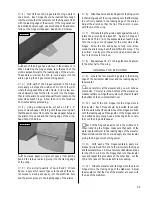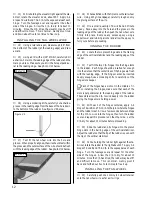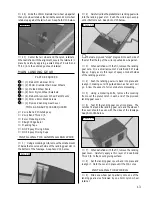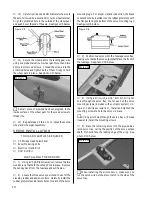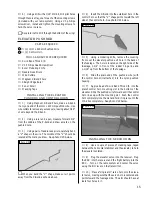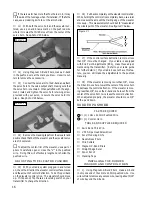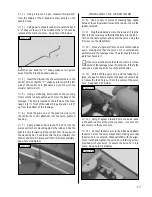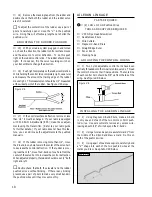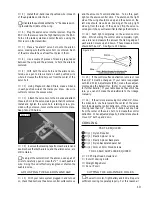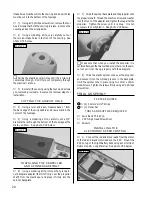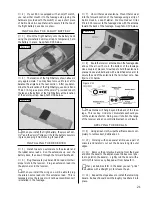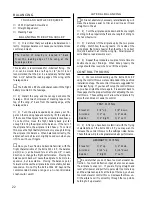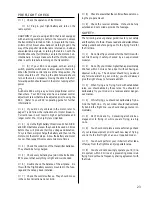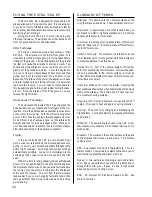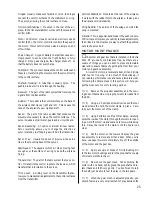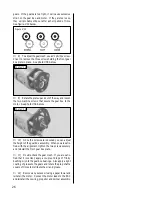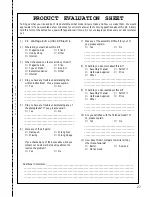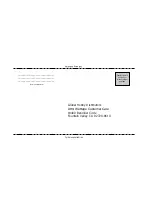
25
Hinges:
Usually made out of plastic or nylon, the hinges
connect the control surfaces to the stabilizers or wing.
They pivot, allowing the control surface to move.
Horizontal Stabilizer:
Mounted in the rear of the air-
plane, the horizontal stabilizer works with the elevator to
control pitch.
Motor Controller:
Usually called an electronic speed
control (ESC), the motor controller controls the speed of
the motor. Motor controllers can also be simple on and
off switches.
Peak Charger:
A type of battery charger that uses a mi-
croprocessor to sense when the flight battery is fully
charged. Once peak charged, the charger shuts off so
that the battery does not overcharge.
Pushrods:
They connect between the control surface and
the servo, transferring the movement of the servo directly
to the control surface.
Pushrod Housing:
A tube that is usually nylon. The
pushrod tube or wire runs through the housing.
Receiver:
The part of the radio system that receives the
signals from the transmitter.
Rudder:
The rudder is the control surface on the back of
the airplane that moves right and left. This causes the
nose of the airplane to yaw right and left.
Servo:
The part of the radio system that produces the
movement necessary to move the control surfaces. The
servo includes a small motor, gears and a circuit board.
Servo Reversing:
An option on almost all new radios.
Servo reversing allows you to change the direction a
servo rotates by just flipping a switch on the transmitter.
Servo Tray:
Usually made out of plywood, the servo
tray is the mounting base for the servos.
Stall Speed:
The speed at which air stops moving fast
enough over the surface of a wing to keep the airplane
flying.
Transmitter:
The part of the radio system that you con-
trol. It transmits the control inputs to the receiver, which
transfers that information to the servos.
Trim Lever:
A sliding lever on the transmitter that al-
lows you to make small adjustments to the control surfaces
from the transmitter.
Vertical Stabilizer:
Mounted on the rear of the airplane,
it works with the rudder to turn the airplane. It also gives
the airplane vertical stability.
Wing Saddle:
The portion of the fuselage on which the
wing is mounted.
Z-Bend:
This is a special bend made in the pushrod wire.
While it cannot improve your ability to make adjustments,
the Z-Bend is the most secure way to attach the pushrod
wire to the servo horn.
☛
The motor and gear box that are installed in the Extra
330L EP are nearly maintenance free, but there are a
couple of things you can do both to prevent premature
wear and to ensure that you're getting the most from your
motor and gear box assembly.
All electric motors, accumulate dust, dirt and grime
after hours of running. If too much of this builds up, it
can lead to performance loss and cause premature wear.
Following the simple steps in this section will help you
get the most out of your motor and gear box.
❑
1) Remove the propeller assembly and the cowl-
ing and set them aside. Unplug the two motor leads from
the ESC.
❑
2) Using a # 0 phillips screwdriver loosen the four
wood screws the hold the motor clamp in place. Care-
fully pull the motor out of the clamp.
❑
3) Using Performance Plus Motor Spray, carefully
spray the inside of the motor, through the two motor open-
ings. Hold the motor up and over an old towel while doing
this. Spray the inside of the motor until the liquid runs
clear.
❑
4) Set the motor on the towel and spray the gear
box assembly to remove any dirt and dust. When you're
done, use paper towels to completely dry off the outside
of the motor and the gear box.
❑
5) Apply a couple of drops of Trinity Bushing Oil
to the two motor bushings and turn the prop shaft a couple
of times to distribute the oil.
❑
6) Now check the gear mesh. While holding the
motor with one hand, lightly grasp the prop shaft and ro-
tate it back and forth very gently. You don't want to turn
the shaft, just be able to feel the play in the two gears.
❑
7) When the gear mesh is adjusted properly, you
should feel only a very small amount of play between the
MOTOR MAINTENANCE

